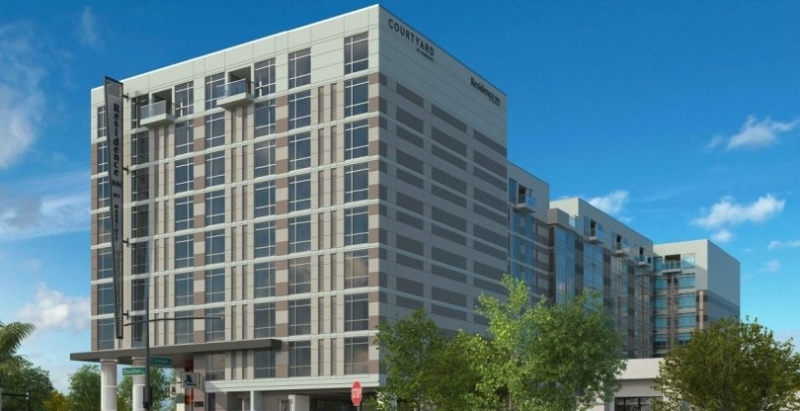By GEORGE AVALOS | gavalos@bayareanewsgroup.com | Bay Area News Group
SAN JOSE — A first-of-its-kind hotel and housing development for San Jose — near downtown San Jose’s Diridon train station and a future Google transit village — has landed two Marriott brands, a project consultant said Tuesday.
Courtyard by Marriott and Residence Inn by Marriott would be the two brands in the hotel, which would contain 311 rooms — and 19 for-sale residential condos — and would be built on a vacant lot at the corner of West Julian Street and Stockton Avenue in San Jose.
“In the City of San Jose, there is no building that has a dual-brand hotel plus residential units,” said Erik Schoennauer, principal executive and partner with Schoennauer Company, a land-use and planning consultancy that is advising the project’s developer. “The project will support the goals of the city’s Diridon Station plan and the Alameda Urban Village plan.”
The residential units would be located on the top floor of the nine-story hotel.
This development represents the first new downtown San Jose hotel development on the west side of State Route 87 in decades, according to Schoennauer. If approved, it would be the closest hotel to Diridon Station.
The hotel and residential project is being developed by Texas-based Kade Development and the designer is Oakland-based Architectural Dimensions.
The combination of hotel rooms and residences would likely make sense, said Scott Knies, executive director of the San Jose Downtown Association.
“It’s an intriguing concept,” Knies said. “The hotel rooms, the residences are compatible.”
The hotel development also helps to widen the concept of the boundaries of downtown San Jose.
“This will be a lot of hotel rooms, and the development would help put a stake in the ground at the northwest edges of the downtown,” Knies said.
Likewise, the Google project and a nearby mega-office campus of 1 million square feet proposed by developers TMG Partners and Valley Oak Partners will, if built, create a dynamic connection between the traditional downtown core and the new frontiers on its western boundaries.
Before the hotel and housing construction could begin, the proposal would need a rezoning approved by the San Jose City Council as well as a planned development permit issued by city staffers.
“The idea is to have a dense, urban, mixed-use development in a walkable, transit-oriented neighborhood,” Schoennauer said.
The hotel and housing would be within a stroll of the transit station, SAP Center, the future Google transit village, the proposed Platform 16 office campus development, Whole Foods and restaurants on The Alameda.
Just down the street from the new hotel project, Google’s planned development would include office buildings where 15,000 to 20,000 of the search giant’s employees would eventually work, along with homes, shops, restaurants and open spaces.
Also not far away from the planned hotel, Adobe Systems has launched a dramatic expansion of its three-building downtown headquarters with a plan to construct an adjacent fourth office tower to accommodate a fast-expanding workforce.
“There is a lot nearby for the business traveler and for the leisure traveler,” Schoennauer said. “You have all the museums and cultural facilities of downtown San Jose very close by.”

